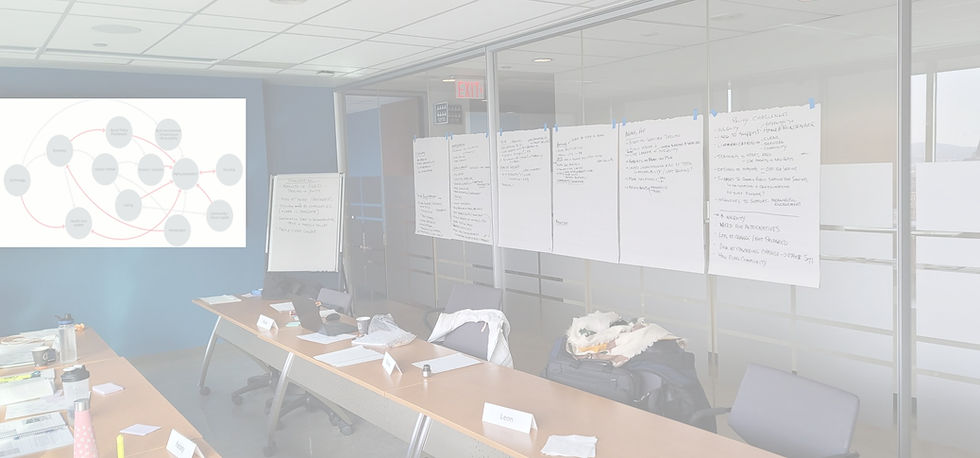System-based scenarios
- ppadbury
- Jun 30, 2024
- 4 min read
Updated: Mar 12
This scenario method assists in understanding how a whole system could evolve, and the surprises, challenges and opportunities could emerge. It provides the "scoffolding" to explore the potential for emergent behavior. It does require more time and effort than many methods. It is designed for very complex public policy problems where due diligence is expected - bearing in mind that we cannot predict the future. The early steps in the FARSI Method are the best preparation.

Photo: (a photo-shopped version) shows the system map (on the left) developed by the group and some of the notes on the impacts of the drivers on each node for one scenario (on the wall on the right). The system map helps the group interactions across the system
This is a shortened version of the FARSI Method for workshops for simple problems/systems:
1. Framing the problem: Agree on the issue, problem or system you want to address.
2. Draw a system map: Have each person draw a system map of their mental model of the system and how it works. Discuss and develop a collective system map that incorporates the key elements of the individual maps. Ideally, the nodes on the map represent key structures or processes in economic, political, social, environmental and/or geostrategic systems (e.g. business, families, institutions, possibly policies, etc.) that are seen as influencing your issue. Ideally, the stakeholders are participants in the room and not nodes on the map. The arrows represent flows of information, resources, decisions, etc. Creating a useful system map is an art. It is often necessary to generalize - to lose detail. But remind participants that the map is an aid for dialogue. It remind them that things are connected. It helps anticipate and reduce unintended consequences. They can recall the underlying subsystems in their imagination and discussion if needed.
3. Agree on the key drivers - ideally, there is a short report or graphic that summarizes potential drivers that is informed by detailed interviews and scanning. For a short three day workshop agree on three to five drivers max.
4. Agree on a scenario logic: In most cases, I find the following logics very accessible and informative: a) status quo continues. b) slow decline of the system, c) incremental reform and adaptation of the system and d) transformation of the system that explore fundamental visionary changes. In each logic, there are unexpected positive and negative surprises across the whole system.
5. Develop scenarios - Explore the impact of drivers on the system map: Focus group attention on the system map. Start with one scenario logic and one driver. Follow the impact of one change driver as it flows across the system map - follow the arrows from node to node. Ask each person to imagine how that node might change. Write on the flip chart the impact of the driver on the system node, especially note any useful, unexpected surprises that are consistent with the scenario. Note: a driver may not impact a node. Use a different coloured marker for each driver.. Repeat for each driver.
In the next step we summarize the collective impact of all the drivers on each node. Each node is a sub-system of the larger system, It can be made up of structures and/or processes that are influenced by stakeholders and flows of resources, decisions and information - potentially from changes in other nodes. The drivers could influence and change stakeholder interests and/or the structures and processes and /or flows to "downstream" nodes.
6. Search for emergence: At this point you have looked at every driver's impact on every node and separately noted their impacts - with different coloured markers. As the drivers interact on a node there is the possibility of "emergence" that transforms the node or leads to new system behaviour. Are there any surprising or disruptive changes that come from the interaction of all the drivers on that node. If emergence is likely, describe it. Do a synthesis statement. Bear in mind that "upstream" change may affect "downstream nodes". In most cases, the impact of the interaction of the drivers with the node is not transformative - so use intuition and critical creativity to determine if emergence is worth exploring and describing in each node.
Facilitation is key: It sounds complicated, but the visual map really helps participants visualize the flows and what could happen. As a facilitator, I have to remind participants of this possibility, but after several times, people started to see it for themselves.
Timing: With a group of ten cooperative, well-intentioned people, four drivers and ten nodes on the system map, it can take three to four hours to complete one scenario.
7. Review the completed scenario to identify challenges and opportunities: Discuss the potential challenges and concerns from each stakeholder’s perspective. Guided imaging can be very useful to put participants "in" the scenario and then help them imagine the challenges and opportunities the scenario creates for current policies, institutions and stakeholders.
6. Test and revise planning assumptions: Think about the current planning assumptions guiding decisions. Are they still relevant in this scenario. If not, restate the planning assumptions so they are robust in this scenario. (After you have finished all scenarios, discuss and create a set of credible planning assumptions that are robust across all scenarios.)
9. Repeat step 4, 5 and 6 for each scenario logic.
10. Summarize all scenarios in a matrix. Put scenario logic across the top columns and system nodes down the rows. These "structural scenarios can be a good basis other products like narrative scenarios, etc.
11. Next Step - Vision-building?: There are several visioning processes. On this site is a vision-building process that uses the insights from system-based scenarios to develop robust visions that address the challenges and get where we want and need to go.
by Peter Padbury, Ottawa, Canada, ppadbury@hotmail.com




Comments